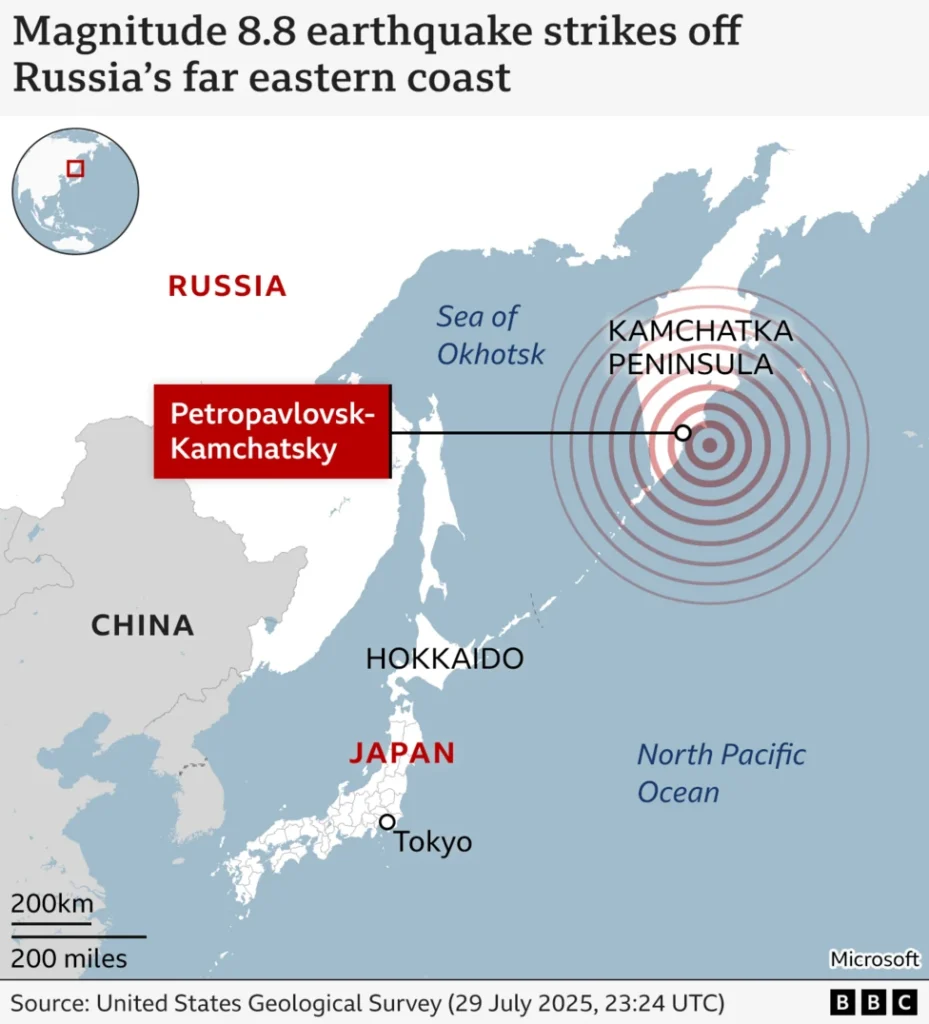Today, at early morning a huge magnitude 8.8 earthquake struck off Russia’s remote Kamchatka Peninsula on July 30, 2025.
Russia earthquake is one of the most powerful quakes recorded globally in over a century.
It prompted tsunami alerts across the Pacific, including Hawaii, Japan, Alaska, and the U.S. West Coast.
Widespread Tsunami Warnings After Russia Earthquake
The Pacific Tsunami Warning Center issued urgent alerts as waves up to 5 metres (16 feet) were recorded in Severo‑Kurilsk, Russia.
Japan saw smaller yet potentially hazardous waves of about 1 metre along its northeastern shores, while Hawaii reported early waves of up to 1.7 metres, triggering coastal evacuations and ship suspensions.
In Kamchatka, the shaking caused building damage and injuries in Petropavlovsk-Kamchatsky, where seismic tremors lasted over three minutes.
Boats were tossed from moorings, and low-lying port areas in Severo‑Kurilsk experienced flooding.
Geology & Historic Comparison
The shallow epicentre—just over 12 km depth—and proximity (~120 km) to populated areas magnified the quake’s surface impact.
Scientists estimate a massive linear rupture of 200–300 miles along a seafloor subduction zone caused significant uplift, which triggered the tsunami.
Local governor Vladimir Solodov described it as the most powerful quake in decades; seismic experts compared it to the 1952 magnitude‑9.0 Severo‑Kurilsk earthquake, which generated 18 metre tsunamis and remains one of the deadliest Russia earthquakes.
Millions of People Left their Homes Due to Russia Earthquake
Hawaii authorities evacuated coastal zones and opened shelters, especially in Maui, where flights were canceled as the Hawaii gauge recorded 1.2 metre tsunami amplitude amid evacuations reaching multiple traffic disruptions.
In Japan, 900,000 people received evacuation orders along advisory zones; precautionary evacuations were executed near the Fukushima nuclear plant, though no anomalies were reported.
A tragic car plunge cliffside in Mie Prefecture resulted in one fatality during a hurried escape.
The U.S. Tsunami Warning System also issued advisories for areas at risk from waves of 1–3 metres, including California and Alaska.
Aftershocks & Recovery Efforts
Multiple strong aftershocks up to magnitude 6.9 followed the 8.8 magnitude Russia Earthquake, keeping scientific teams vigilant but avoiding any further major damage.
Crisis management agencies reported minimal structural collapse in Ordinary buildings; fears of larger shakings remain but were mitigated by lower-than-expected localized intensities.
Emergency services in Severo‑Kurilsk urged residents to inspect homes before resuming gas stove ovens and electric connections to avoid secondary hazards. Power outages affected nearby Sakhalin region, and efforts focused on restoring infrastructure.

Key Takeaways:
- This event ranks among the world’s strongest recorded earthquakes, comparable to other disasters such as the 1952 Kamchatka quake and the 2011 Tōhoku disaster.
- Early tsunami detection and rapid alerts saved lives across multiple nations, though even 1–3 metre waves pose lethal risk in coastal zones due to flooding and debris.
- Continual monitoring and preparedness remain critical in regions along the Pacific Ring of Fire, where subduction zones regularly trigger powerful seismic events.
Source: Reuters


